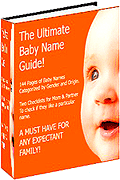Popular Names -
by: Florence Murphy
Breastfeeding Is Natural
Babies need to eat often — every 90 minutes to two hours. Feed your baby when she begins to show signs of hunger, such as rooting or sucking on her lips, fingers or fist. Try to feed her before she cries. Feeding your baby often won’t spoil her. It will help you learn to become more aware of your baby’s needs.
Don’t limit feeding times. Babies need different amounts of food at different times of the day, just as grown people do.
Relax! Take your time. The more you nurse your baby, the more milk you will have. Do not give your baby formula or water. If you do, you will make less milk. If you think you do not have enough milk, nurse more often and nurse longer.
To learn more about breastfeeding, you may want to contact your local health department, WIC clinic, hospital, La Leche league or doctor. You can call La Leche league at 1-800-LALECHE, or visit their Web site at www.lalecheleague.org/.
Breastfeeding is natural, but it takes a little time for babies and mothers to learn what works best for them. You may have sore nipples when you first start breastfeeding. The pain can be reduced if your baby is held properly when attached to the breast.
Here are some useful tips:
• Hold your baby’s tummy to your tummy, baby’s chin to your breast. You can do this sitting or lying down. Hold your breast in a “C-hold,” with your thumb on top and fingers underneath. Tickle your baby’s lips with your nipple until her mouth opens wide. Quickly bring her onto the breast. Allow the tip of your baby’s nose and chin to touch the breast.
• Make sure your baby’s mouth covers your entire nipple and much of the darker part around the nipple. Your baby’s upper and lower lips should be rolled out. If the lips are not rolled out, break the suction by slipping your finger between the baby’s gums and your breast. Then latch the baby on again.
• Offer your baby both breasts at each feeding. Your baby will tell you when she is finished by “falling off” the breast.
• After feeding, rub a few drops of breast milk onto your nipples. Let them air dry. Then cover the nipple with nursing pads, a bra or clothing. This will help keep them from getting too dry.
Your nipples may be tender in the first few days of breastfeeding. This is common. By and large, tenderness goes away once the milk begins to flow. If you have a lot of pain, call a breastfeeding counselor or your doctor. Your doctor or counselors can also help if you have cracked or bleeding nipples. If it doesn’t feel right, then it probably isn’t right.
If you are out with your baby, you can still breastfeed. You may want to take along a receiving blanket or shawl with which to cover up.
(continued...)
Breast Feeding or Bottle Feeding Your New Baby
Page 2
About The Author
Florence Murphy is a mother of 4 and a grandmother of 2. She is pleased to present her new book First Baby Years to all new and expecting parents.
|
